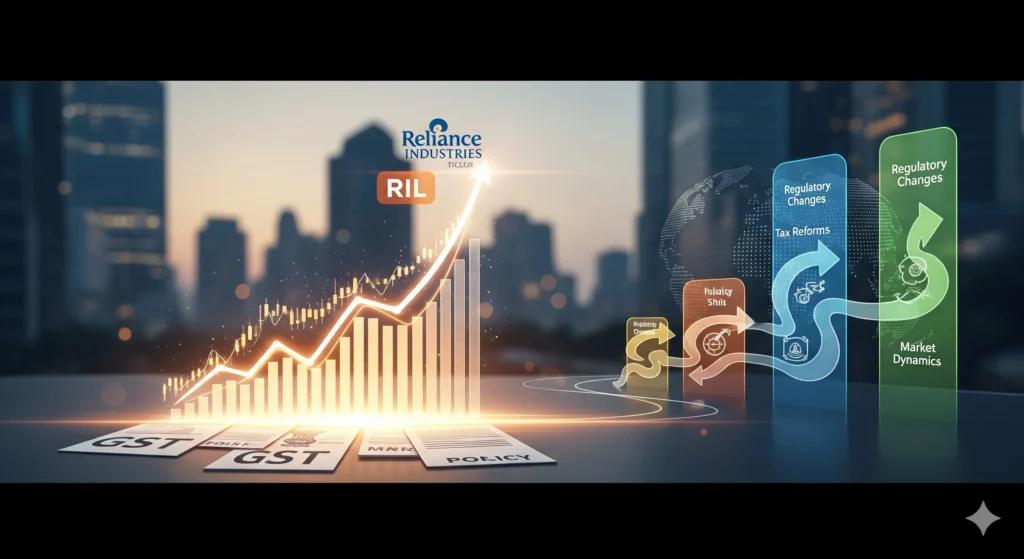Reliance Industries drives market benchmarks higher ahead of crucial GST Council meeting scheduled for September 3-4, 2025. The conglomerate’s shares surged over 2%, single-handedly boosting Sensex by 200+ points and pushing Nifty toward the significant 24,700 mark.
Key Market Catalysts
Investment Outlook: With heavy weighting in Nifty (13.2%) and Sensex (11.8%), RIL’s performance directly influences broader market sentiment. The company’s proven track record of navigating policy changes positions it well for potential GST rationalization benefits, making it a key stock to watch for both institutional and retail investors.
For a new investor entering the dynamic world of the Indian stock market, the sheer volume of information can be overwhelming. Companies rise and fall, economic policies change, and market sentiments shift daily. However, observing how market giants navigate these waters provides invaluable lessons. A recent prime example is the performance of Reliance Industries Limited (RIL), which has once again demonstrated its profound influence by significantly boosting key market benchmarks in the days leading up to a crucial GST Council meeting.
This article will deconstruct Reliance’s recent rally, explaining the strategic drivers behind it and offering insights into how you, as a new investor, can understand and learn from such market-moving events.
The Benchmark-Boosting Performance
In the first week of September 2025, Reliance Industries emerged as the undisputed star performer on the Indian bourses. Its shares surged by over 2%, single-handedly propelling the Sensex to a gain of more than 200 points and pushing the Nifty 50 index toward the significant 24,700 mark.
This wasn’t a random spike. The momentum was fueled by a powerful combination of positive analyst sentiment and optimism surrounding impending policy decisions. Global brokerage giants like Morgan Stanley and J.P. Morgan upgraded their price targets for RIL, reaffirming a strong “Overweight” or “Buy” rating. They cited the conglomerate’s resilient business model, its innovative green energy roadmap, and its strategic positioning to benefit from both domestic reforms and global economic shifts, such as China’s efforts to curb manufacturing overcapacity.
*Table 1: Reliance Industries’ Key Financial Snapshot (FY 2024-25)*
| Metric | Value (in ₹ Crore) | Growth/Note |
| Annual Revenue | 10,71,174 | 7.1% Increase Year-on-Year |
| EBITDA | 1,83,422 | Supported by Oil & Gas, Jio, Retail |
| Profit After Tax (PAT) | 81,309 | Strong bottom-line performance |
| Jio Platforms Customer Base | 500 Million+ | Foundation of digital services revenue |
| Retail Presence | Massive Pan-India Expansion | Continual growth driver |
This pre-GST rally is a classic case of “smart money” following informed analysis. Investors, buoyed by these expert opinions, placed their bets on Reliance, anticipating that the company was perfectly poised to capitalize on the outcomes of the GST Council meeting.
The Strategic Drivers Behind the Rally
Why exactly are analysts so bullish on Reliance? The answer lies in its multi-pronged growth strategy.
1. The Green Energy Gambit: Reliance is not just an oil-and-gas giant anymore. It is aggressively constructing what it calls the “world’s most integrated new energy ecosystem.” With a sharp focus on solar power, hydrogen fuel, and other renewable assets, the company aims to reduce its energy costs by 40% by 2030. This isn’t just good for the planet; it’s excellent for business. Morgan Stanley estimates that this green energy push could contribute 13% to RIL’s earnings by 2027 and add a staggering $20 billion to its net asset value in the coming years. This future-proofing of its business model excites long-term investors.
2. Diversification and Restructuring: Reliance’s strength lies in its three powerful pillars: Oil-to-Chemicals (O2C), Retail, and Digital Services (Jio). This diversification acts as a natural hedge. If one sector faces headwinds (like margin pressures in O2C), the others (like the booming retail and telecom businesses) can pick up the slack. The company’s self-driven restructuring, combining these verticals with new ventures in FMCG and AI, creates immense synergies. Its commitment to double its EBITDA between FY22 and FY27 shows a clear, measurable growth trajectory that analysts trust.
The GST Connection: Catalyzing Market Optimism
The Goods and Services Tax (GST) is one of India’s most significant economic reforms, designed to create a unified national market. For investors, GST Council meetings are critical events as they can announce changes in tax rates, compliance procedures, and sector-specific policies.
Reliance, as a conglomerate spanning energy, retail, and telecom—all sectors deeply sensitive to GST—is uniquely positioned to benefit from a more streamlined and efficient tax regime. Investors anticipate that potential GST rationalization could lead to:
- Reduced compliance costs.
- A more efficient supply chain with lower logistics costs.
- Increased formalization of the economy, benefiting large, organized players like Reliance.
This isn’t the first time Reliance has thrived during a GST shift. During the initial rollout in 2017, while many companies struggled with destocking and adjusting to new systems, Reliance’s performance remained robust. Historical data showed that in the transition quarter, while corporate net sales growth (excluding RIL) was a modest 6.5%, including Reliance pushed that figure to over 14%—a clear testament to its ability to navigate regulatory changes better than most
A Lesson for New Investors: How to Think About Policy and Stocks
As a new investor, watching Reliance’s moves provides a playbook on how blue-chip companies leverage policy changes:
- Strategic Communication: Reliance proactively engages with investors, regulators, and partners before big policy shifts, managing expectations and demonstrating preparedness.
- Operational Excellence: They invest heavily in technology and supply chain optimization to adapt quickly, turning a potential disruption into a competitive advantage.
- Financial Resilience: With strong cash flows and a healthy balance sheet, they can absorb short-term shocks and invest for growth when others are cutting back.
Conclusion: More Than Just a Stock, a Market Pillar
Reliance Industries is more than just a company to invest in; it is a barometer for the Indian economy. Its heavy weighting in the Nifty and Sensex means its performance directly lifts the entire market. Its recent rally ahead of the GST meeting is a powerful reminder of how foresight, diversification, and operational excellence can create a virtuous cycle of investor confidence.
For someone new to the share market, the key takeaway is to look for companies that, like Reliance, are not just participants in the economy but are actively shaping it, are transparent in their communication, and have a proven track record of turning challenges into opportunities. While past performance is not an indicator of future returns, understanding the strategy behind the performance is the first step toward making informed investment decisions.
Disclaimer: This article is for educational and informational purposes only. It is not a recommendation to buy or sell any securities. The data presented is based on publicly available information and hypothetical illustrations. Investors are advised to conduct their own research and consult with a qualified financial advisor before making any investment decisions.



